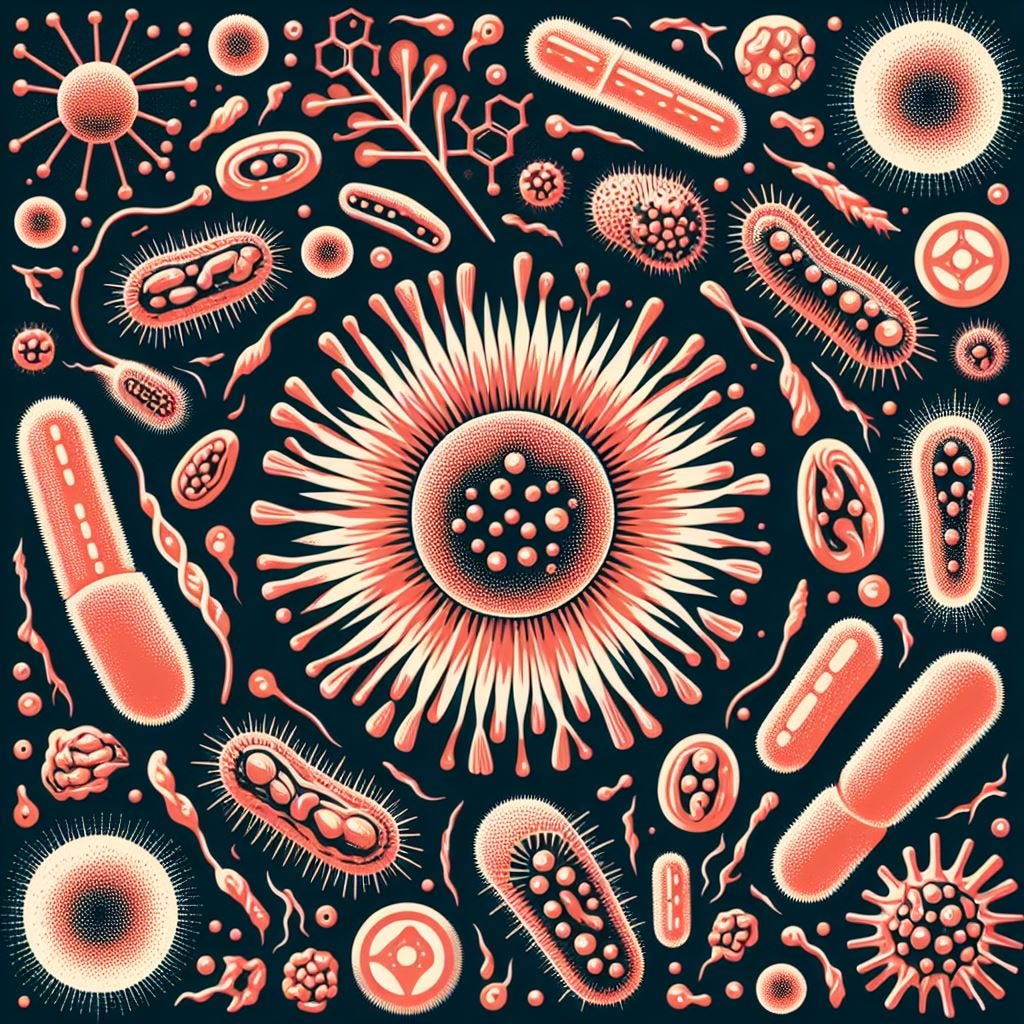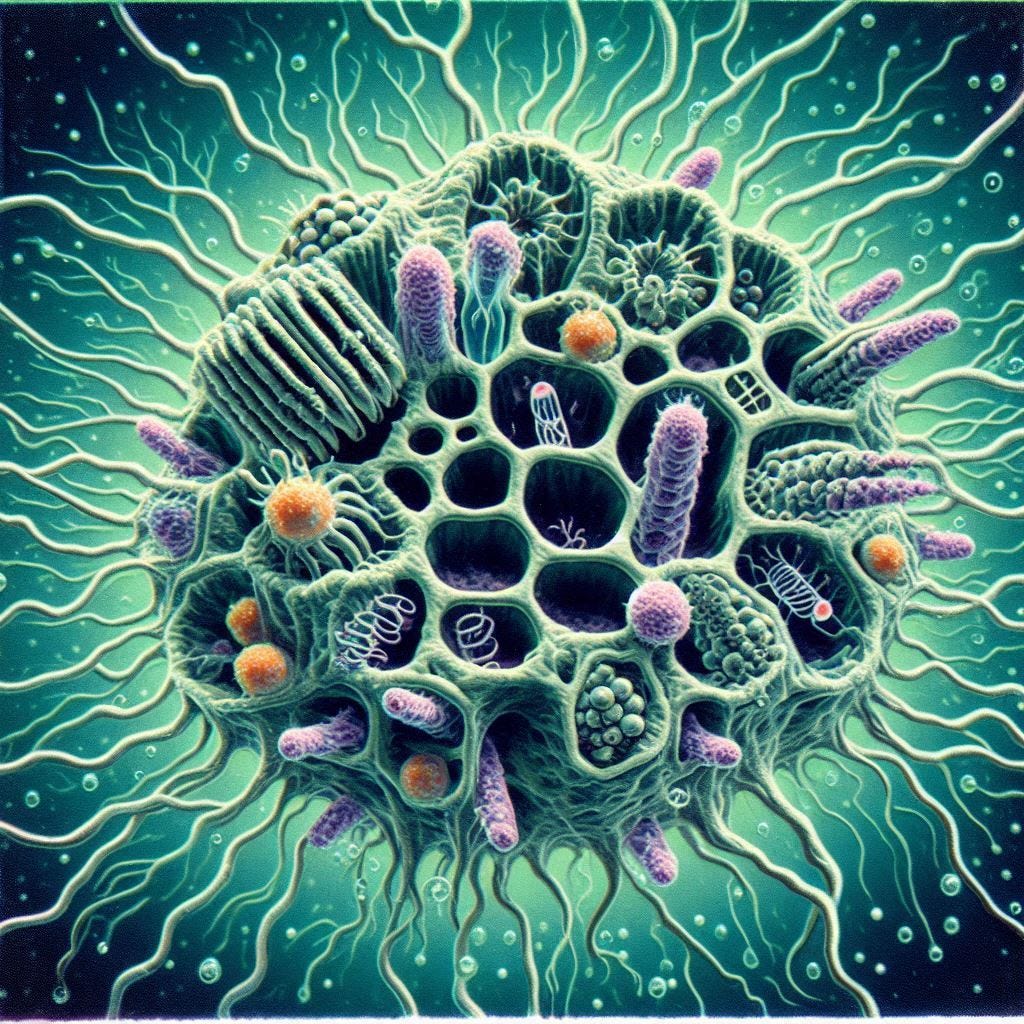Weekly Updates | April 14 | #8
Update #1 | New Parkinson’s variant
In a recently published study, researchers discovered a new genetic variant, RAB32 Ser71Arg, linked to Parkinson's disease. This genetic mutation was found in three families and 13 other individuals from different countries, suggesting they are all distant cousins. The RAB32 Ser71Arg variant interacts with proteins involved in early- and late-onset parkinsonism, as well as non-familial Parkinson's disease, and causes dysfunction within cells. The proteins encoded by the linked genes regulate dopamine levels, autophagy processes, immunity within cells, and mitochondrial function. This discovery provides insights into the evolutionary origin of familial parkinsonism and opens avenues for better understanding and treatment of the disease.
Key points:
Parkinson's disease is a progressive neurodegenerative disorder that impairs a person's ability to function.
There is currently no treatment to slow or halt Parkinson's disease, and available drugs can only treat certain symptoms.
Genetic and environmental factors contribute to the development of Parkinson's disease.
Linkage analysis and genome-wide association studies are used to identify genetic variations associated with Parkinson's disease.
Researchers identified a new genetic variant, RAB32 Ser71Arg, linked to Parkinson's disease in three families and additional individuals.
The RAB32 Ser71Arg variant interacts with proteins involved in parkinsonism and causes dysfunction within cells.
The linked genes and proteins play a role in regulating dopamine levels, autophagy processes, immunity within cells, and mitochondrial function.
Understanding the genetic basis of Parkinson's disease is crucial for developing effective treatments.
Highlights:
Researchers have discovered a new genetic variant, RAB32 Ser71Arg, linked to Parkinson's disease.
This genetic mutation was found in multiple families and individuals from various countries, suggesting a shared ancestry.
The RAB32 Ser71Arg variant interacts with proteins involved in Parkinson's disease and causes dysfunction within cells.
The linked genes and proteins play a role in regulating dopamine levels, autophagy processes, immunity within cells, and mitochondrial function.
This discovery improves our understanding of the genetic basis of Parkinson's disease and may lead to better treatments.
References:
Update #2 | New technique for mRNA delivery
Researchers at Tokyo Medical and Dental University have developed a new coating method for mRNA engineering that allows for the selective delivery of engineered mRNAs to the spleen. By coating the mRNAs with polyethylene glycol (PEG), the researchers were able to prevent the accumulation of mRNAs in the lungs and facilitate effective delivery to the spleen. This method has the potential to significantly advance the therapeutic use of mRNA polyplexes.
Key points:
mRNA therapeutics involves delivering mRNA molecules into the body to provide the cellular machinery with the blueprint for producing specific proteins.
Coating engineered mRNAs with polyethylene glycol (PEG) allows for selective delivery to the spleen.
Polyplexes, which are structures that package the engineered mRNAs, tend to accumulate in the lungs without modification.
Treating polyplexes with PEG prevents them from sticking together, but applying PEG to the polyplex surface in a controlled manner is difficult.
The researchers at Tokyo Medical and Dental University developed a new method of PEGylation, where the mRNAs are hybridized to PEG molecules before the polyplexes are formed.
Using this method, the researchers found that the quantities and lengths of the PEG molecules affected the efficacy of mRNA therapy.
Short PEG molecules prevented the accumulation of mRNAs in the lungs and facilitated effective delivery to the spleen.
This new coating method has the potential to advance the therapeutic use of mRNA polyplexes.
Highlights:
The research demonstrates the potential for fine-tuning the amount of PEGylation of mRNA polyplexes, allowing control over their physicochemical properties and biological functionalities.
This method has utility in mRNA vaccines and has the potential to treat diseases previously considered incurable and develop novel cancer treatments and vaccines.
The researchers used a mouse model to study the effects of the coating method.
References:
Miki Suzuki et al, Poly(ethylene Glycol) (PEG)–OligoRNA Hybridization to mRNA Enables Fine‐Tuned Polyplex PEGylation for Spleen‐Targeted mRNA Delivery, Small Science (2024). DOI: 10.1002/smsc.202300258
Update #3 | Antibiotic for drug resistant bacteria
Scientists at Uppsala University in Sweden have discovered a new class of antibiotic that has the potential to eliminate drug-resistant bacterial infections. The antibiotic targets the double membrane surrounding gram-negative bacteria, such as Escherichia coli and Klebsiella pneumoniae, which are known to cause various infections. The researchers targeted an enzyme called LpxH, which helps synthesize critical components of the bacteria's outer membrane. In tests on mice, the antibiotic successfully treated bloodstream infections with just one dose. However, further development and testing are required before the antibiotic can be used in clinical trials.
Key points:
Scientists have identified a new class of antibiotic that could tackle drug-resistant bacterial infections.
The antibiotic targets the double membrane surrounding gram-negative bacteria, which are known to cause various infections.
The researchers focused on an enzyme called LpxH, which is crucial for the synthesis of critical components in the bacteria's outer membrane.
Tests on mice showed that the new antibiotic successfully treated bloodstream infections with just one dose.
Further research and development are needed before the antibiotic can progress to clinical trials.
Highlights:
The newly discovered antibiotic has the potential to combat drug-resistant bacterial infections.
Gram-negative bacteria, such as Escherichia coli and Klebsiella pneumoniae, pose a significant challenge due to their tough outer membranes.
The antibiotic targets an enzyme called LpxH, which plays a key role in synthesizing components of the bacteria's outer membrane.
Mice infected with drug-resistant bacteria were treated successfully with just one dose of the antibiotic.
The antibiotic needs further refinement and testing before it can be used in clinical trials.
References:
Update #4 | First Genetic maps for disease causing DNA
Researchers at the University of California, Irvine have created the first genetic reference maps for short lengths of DNA repeated multiple times that are associated with over 50 fatal human diseases. The database, called UC Irvine TR-gnomAD, allows researchers to study the connection between tandem repeat expansions and diseases, improving diagnostics and understanding health disparities. The team analyzed genomic data from over 338,000 participants and identified over 900,000 repeat sequences.
Key points:
Researchers at the University of California, Irvine have developed the first genetic reference maps for disease-linked DNA repeat sequences.
The maps are associated with over 50 lethal human diseases, including amyotrophic lateral sclerosis, Huntington's disease, and multiple cancers.
The UC Irvine TR-gnomAD database enables researchers to study how these repeat sequences are connected to diseases and improve diagnostics.
The research team analyzed genomic data from over 338,000 participants and identified over 900,000 repeat sequences.
The database will help improve our understanding of health disparities and advance personalized precision medicine.
Highlights:
The UC Irvine TR-gnomAD database addresses a critical gap in current genome sequencing efforts by providing reference maps for disease-linked DNA repeat sequences.
Tandem repeat expansions make up about 6% of the human genome and contribute to complex congenital conditions, but scientific understanding is limited.
The database will help prioritize the integration of a greater number of high-quality repeat sequences and include more underrepresented ancestries.
References:
Cui, Y., et al. (2024) A genome-wide spectrum of tandem repeat expansions in 338,963 humans. Cell. doi.org/10.1016/j.cell.2024.03.004.
Update #5 | Discovery of Zombie neurons
Scientists studying learning in mice have discovered "zombie neurons" in the brain. These neurons are cells that stop interacting normally, despite being functionally alive. The researchers used optogenetics to manipulate cells in the cerebellum, a part of the brain involved in learning, and found that certain cerebellum inputs called climbing fibers play a key role in associative learning. They also noticed that introducing a light-sensitive protein into the climbing fibers caused them to become "zombified," preventing the mice from being able to learn.
Key points:
Scientists studying learning in mice have discovered "zombie neurons" in the brain.
These cells, known as climbing fibers, play a key role in associative learning in the cerebellum.
Introducing a light-sensitive protein into the climbing fibers caused them to stop interacting with other neural circuits, preventing the mice from being able to learn.
Highlights:
The discovery of "zombie neurons" sheds new light on learning processes in the brain.
The study provides compelling evidence that climbing fiber signals are essential for cerebellar associative learning.
Understanding why the introduction of the light-sensitive protein caused the climbing fibers to become "zombified" is the next step in the research.
References:
Update #6 | First molecular fractal in nature
An international team of researchers has discovered the first regular molecular fractal in nature. They found that a microbial enzyme called citrate synthase from a cyanobacterium spontaneously assembles into a pattern known as the Sierpinski triangle. The fractal structure emerged through a small number of mutations and may represent an evolutionary accident.
Key points:
The team discovered a microbial enzyme, citrate synthase, from a cyanobacterium that forms a regular fractal pattern known as the Sierpinski triangle.
The fractal structure emerged through a small number of mutations and was then lost in several cyanobacterial lineages.
The regularity of fractals at the molecular level is extremely rare in nature.
The fractal protein's assembly violated the rule of symmetry, causing it to form the Sierpinski triangle.
Highlights:
Regular fractal structures are rare in nature, but the discovery of a regular molecular fractal suggests that there may be more undiscovered molecular assemblies in biomolecules.
The fractal structure of the enzyme may have been an evolutionary accident that was easy to evolve.
The fractal formation does not seem to serve any specific function for the bacterium.
References:
Franziska L. Sendker et al, Emergence of fractal geometries in the evolution of a metabolic enzyme, Nature (2024). DOI: 10.1038/s41586-024-07287-2
Update #7 | First N2-fixing organelle in a eukaryotic cell
Scientists have discovered the first known nitrogen-fixing organelle within a eukaryotic cell. Previously, it was believed that only bacteria could convert nitrogen from the atmosphere into a usable form for life. The organelle, called a nitroplast, is the fourth example of primary endosymbiosis—the process by which a prokaryotic cell is engulfed by a eukaryotic cell and evolves into an organelle. The discovery has the potential to change our understanding of nitrogen fixation and could provide insights for engineering natural nitrogen fixation into crop plants.
Key points:
Scientists have discovered the first nitrogen-fixing organelle within a eukaryotic cell.
The organelle, called a nitroplast, is the fourth example of primary endosymbiosis.
Nitrogen fixation is important for all organisms as it converts nitrogen from the atmosphere into a usable form.
The discovery could change our understanding of nitrogen fixation and has potential applications in agriculture.
Further research is needed to understand the function and operation of the nitroplast.
Highlights:
Modern biology textbooks state that only bacteria can convert nitrogen from the atmosphere into a usable form.
Nitrogen-fixing plants, such as legumes, rely on symbiotic bacteria in their root nodules.
The discovery of the nitroplast challenges the idea that only bacteria can fix nitrogen.
The nitroplast is the fourth example of primary endosymbiosis, a process where a prokaryotic cell becomes an organelle within a eukaryotic cell.
The discovery provides insights into the evolution of organelles and has potential applications in agriculture.
References:
Tyler H. Coale et al, Nitrogen-fixing organelle in a marine alga, Science (2024). DOI: 10.1126/science.adk1075
Update #8 | Replication abilities of RNA
Scientists from Ludwig Maximilian University of Munich have discovered that life's complexity could originate from simple RNA molecules on early Earth. Through experiments, they demonstrated RNA's recycling and replication abilities under specific conditions, challenging prior assumptions about RNA's evolution. The research suggests that life could emerge from minimal molecular sets in environments similar to volcanic islands.
Key points:
Research from Ludwig Maximilian University of Munich reveals that life's complexity could originate from simple RNA molecules on early Earth.
The study demonstrates RNA's recycling and replication abilities under specific conditions, such as low salinity and high pH.
The research challenges prior assumptions about RNA's evolution and suggests that life could emerge from minimal molecular sets in environments similar to volcanic islands.
Highlights:
RNA molecules release water as they form bonds, but on early Earth, where seawater was dominant, releasing water was challenging.
The scientists showed that RNA's recycling capabilities and the right ambient conditions, like low salinity and high pH, played a decisive role in the development of complexity.
The researchers found that RNA has the ability to split without adding a water molecule, allowing it to reform and copy sequences when bound to a template RNA molecule with matching base pairs.
The study suggests that complex ribozyme sequences, previously thought necessary for RNA evolution, are not needed, and that life could emerge from a simple, cold prebiotic environment.
The research indicates that alkaline freshwater environments, like those found on volcanic islands, may have allowed life to emerge.











